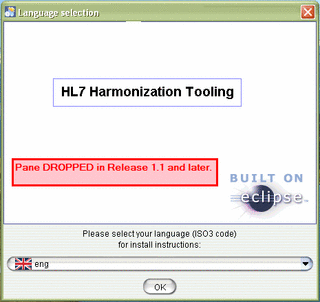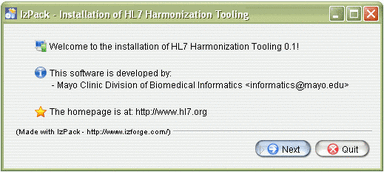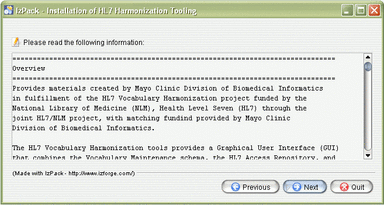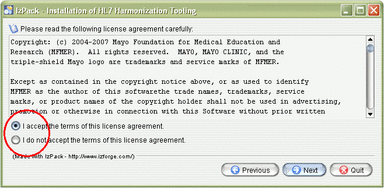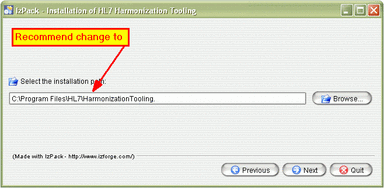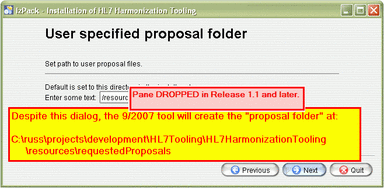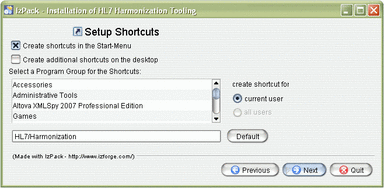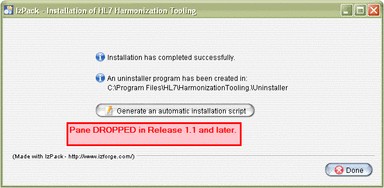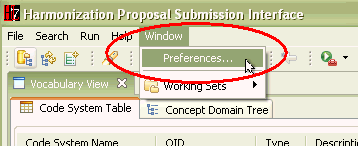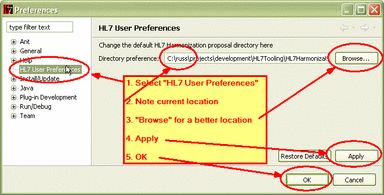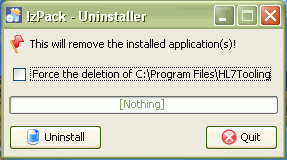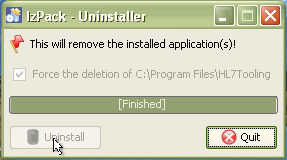Difference between revisions of "VocApp-Install"
| Line 27: | Line 27: | ||
| | | | ||
| '''Note''' Regardless of this selection, proposals will be placed at:<br/><code>C:\russ\projects\development\HL7Tooling \HL7HarmonizationTooling\resources \requestedProposals</code><br/> | | '''Note''' Regardless of this selection, proposals will be placed at:<br/><code>C:\russ\projects\development\HL7Tooling \HL7HarmonizationTooling\resources \requestedProposals</code><br/> | ||
| + | |||
| + | This setting '''can be changed after installation'''. Go to [[#Setting file preferences|'''<u>Setting file preferences</u>''']] to change this. | ||
|- | |- | ||
| [[Image:VocAppInstall-041.gif|thumb|center|384px|Installer packaging options]] | | [[Image:VocAppInstall-041.gif|thumb|center|384px|Installer packaging options]] | ||
| Line 38: | Line 40: | ||
|} | |} | ||
:{{to-top}} | :{{to-top}} | ||
| + | ===Setting File Preferences=== | ||
| + | Th location in which the application looks for and saves change proposal files '''can be changed''' through the Eclipse '''''Preferences''''' dialog. | ||
| + | {| align="center" style="text-align:left" | ||
| + | |- | ||
| + | | valign="top"| | ||
| + | #Select '''Menu...Window...Preferences...''' on the menu bar as shown at right | ||
| + | |[[Image:VocAppPreferences-010.gif|thumb|center|384px|Selecting the '''Menu...Window...Preferences''' to reach the Preferences dialog]] | ||
| + | |- | ||
| + | | valign="top"| | ||
| + | Within the '''''Preferences''''' dialog (as shown at right), change the file location for Vocabulary Change Requests as follows: | ||
| + | #Select '''''HL7 User Preferences''''' from the left-hand pane to show the right-hand pane | ||
| + | #Note the current location, as you may have files stored there | ||
| + | #Use the '''Browse''' button to select a preferred location | ||
| + | #Click '''Apply''' to save the new setting | ||
| + | #Click '''OK''' to close the dialog | ||
| + | #'''Exit and Restart the application''' in order to refresh the contents of the '''''ProposalView''''' pane | ||
| + | |[[Image:VocAppPreferences-020.gif|thumb|center|384px|Sequence of selections on the '''''Preferences''''' dialog to change the target directory for Vocabulary Change Proposals.]] | ||
| + | |} | ||
===Uninstall Application=== | ===Uninstall Application=== | ||
Because this application is installed with a Java JAR-self-installer, it does not appear in the Windows "Add/Remove Programs" control panel. There is however an uninstall routine that is installed along with the application. It can be activated from the '''Start Programs''' menu as shown in the following figure: | Because this application is installed with a Java JAR-self-installer, it does not appear in the Windows "Add/Remove Programs" control panel. There is however an uninstall routine that is installed along with the application. It can be activated from the '''Start Programs''' menu as shown in the following figure: | ||
Revision as of 17:41, 15 October 2007
Contents
Installation
The installation of all HL7 applications, and the preparation of the underlying operating environment is documented by the Tooling Committee in Installing and Configuring HL7 Tools.
- Go to Vocabulary Tool installation instructions to find the installer and begin the installation
This section of the application manual simply points out the steps and then links to the relevant sections of Installing and Configuring HL7 Tools.
Install Java Runtime
The Harmonization Editor is a Java-based tool that executes in the Eclipse platform. However, the Eclipse platform does not need to be installed as the Harmonization Editor installer installs a "runtime" version of the platform.
To find and install the latest Java runtime environment (JRE) see the installation instructions in the reference file.
Install Application
The basic installation instructions are found in the installation resource file, but that file does not show the selection screens that appear as the installation proceeds. Omce the user 'double-clicks the self-installing JAR file, the installation dialog windows appear in the following sequence. The captions identify the screen shot, and some figueres have textual comments below them.
| Select "I agree..." radio button to enable "Next" button. | Note recommend change to C:\Program files\HL7\Harmonization tooling |
Note Regardless of this selection, proposals will be placed at:C:\russ\projects\development\HL7Tooling \HL7HarmonizationTooling\resources \requestedProposalsThis setting can be changed after installation. Go to Setting file preferences to change this. | |
| Once the installation progress is complete, the Next button will be enabled. | |
Setting File Preferences
Th location in which the application looks for and saves change proposal files can be changed through the Eclipse Preferences dialog.
|
|
|
Within the Preferences dialog (as shown at right), change the file location for Vocabulary Change Requests as follows:
|
Uninstall Application
Because this application is installed with a Java JAR-self-installer, it does not appear in the Windows "Add/Remove Programs" control panel. There is however an uninstall routine that is installed along with the application. It can be activated from the Start Programs menu as shown in the following figure:
Selecting the Uninstall HL7 Harmonization Editor option will launch the install process with the following screen:
The only selection other than Uninstall or Quit is whether to select the option Force the deletion of <<installation directory>>. The results of this option are:
- Not selected - The application will be removed, but data content, such as proposal files, that are stored under the installation directory will be retained.
- Selected - The application will be removed, and all files under the installation directory will be removed whether or not they were part of the original installation.
Selecting Uninstall converts this pane into a progress bar that continues until the removal is complete, and only the Quit remains, as below:
